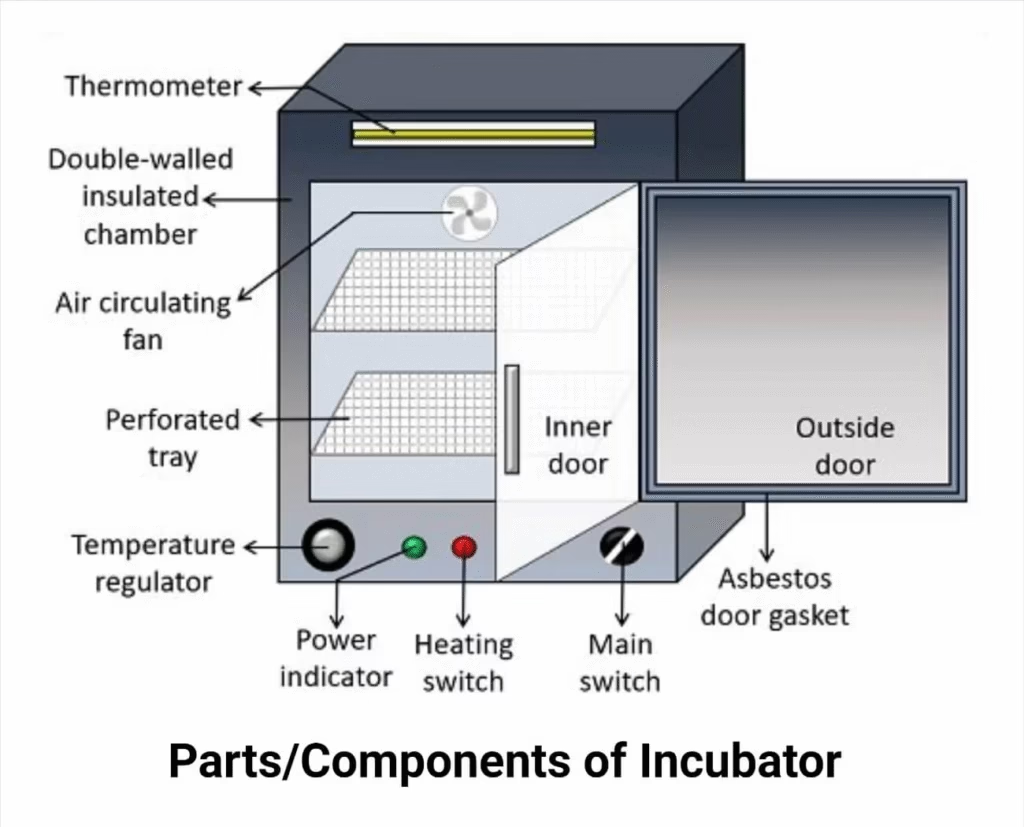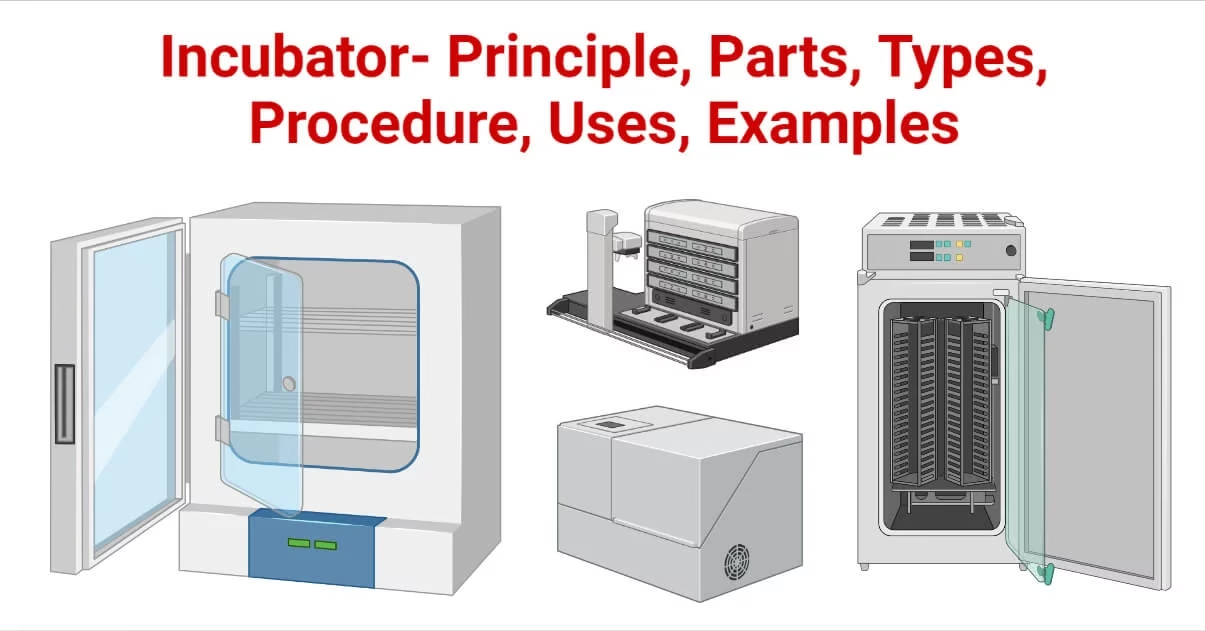What is a Laboratory Incubator?
- A laboratory incubator is a heated, insulated chamber designed to provide a controlled environment for the growth, storage, and preservation of biological cultures such as bacteria, fungi, yeast, and mammalian cells.
- It regulates temperature, humidity, CO₂ concentration, and sterility to mimic natural growth conditions.
- Widely used in microbiology, biotechnology, pharmaceuticals, food testing, agriculture, and medical research.
- Ensures contamination-free, stable, and reproducible results.
In short: An incubator provides the perfect artificial environment for microorganisms and cell cultures to grow.
Principle of Laboratory Incubator
- Laboratory incubators work on the principle of thermoelectricity and heat regulation.
- A thermostat maintains constant temperature by generating a thermal gradient.
- When power is supplied:
- Heating elements (bulbs or coils) warm the chamber.
- A fan distributes hot air evenly.
- A digital temperature controller switches heaters on/off to maintain set values (commonly 37°C).
- Some incubators also regulate CO₂ concentration (for mammalian cells) and humidity (to prevent drying).
This ensures a constant, contamination-free environment similar to natural conditions.
Components of a Laboratory Incubator

1. Cabinet
- Double-walled insulated chamber (20–800 L capacity).
- Outer wall → stainless steel; inner wall → aluminum.
- Insulated with glass wool to prevent heat loss.
2. Door
- Insulated and airtight.
- May include a glass viewing panel for observation without disturbing conditions.
3. Control Panel
- Located on outer wall.
- Includes switches, indicators, thermostat controls, and digital display (in modern incubators).
4. Asbestos/Gasket Seal
- Ensures airtight closure between door and cabinet.
- Prevents external air from entering.
5. Shelves (Perforated)
- Hold culture plates, flasks, or tubes.
- Perforations allow uniform hot air circulation.
6. Thermostat & Temperature Sensors
- Maintain desired temperature range (20–100°C).
- Digital incubators provide greater accuracy than analog ones.
7. Thermometer
- L-shaped thermometer fixed outside for temperature monitoring.
8. HEPA Filters (in advanced incubators)
- Maintain sterile airflow.
- Reduce contamination risk.
9. Humidity & Gas Controllers
- Maintain >90% humidity.
- CO₂ regulators for cell culture incubators.
Types of Laboratory Incubators
Incubators are classified based on purpose, function, or design:
1. Cooled / Refrigerated Incubator
- Has an internal cooling system.
- Maintains temperatures below ambient.
- Used for enzyme studies, BOD tests, and low-temp culture growth.
2. Shaking Incubator
- Combines incubation + agitation.
- Provides oxygenation and nutrient distribution.
- Used for bacterial, yeast, and tissue cultures.
3. Portable Incubator
- Small, lightweight, battery-powered.
- Used in remote areas for microbiological testing.
4. Benchtop Incubator
- Compact, temperature range: ambient – 100°C.
- Often includes alarms, timers, and digital displays.
5. CO₂ Incubator
- Maintains 37°C, >90% humidity, and 5% CO₂.
- Mimics human physiological conditions.
- Used for mammalian cell and tissue culture.
6. BOD Incubator
- Maintains 20–25°C.
- Used for Biological Oxygen Demand testing in water samples.
7. Light Incubator
- Equipped with light sources for plant growth experiments.
- Used in agriculture and botany labs.
8. Anaerobic Incubator
- Provides oxygen-free environment.
- Used for cultivating anaerobic bacteria.
9. Constant Temperature & Humidity Incubator
- Provides precise temperature + humidity control.
- Used in biotech and industrial testing.
10. Analog vs Digital Incubators
- Analog: Simple, cheap, less accurate.
- Digital: More expensive, accurate, with digital displays.
Operating Procedure of an Incubator
- Place incubator on a stable surface and connect to power supply.
- Switch on the main power and control panel.
- Set desired temperature using control knobs or digital display.
- Allow chamber to stabilize before placing samples.
- Place culture plates inverted (lid at bottom) to avoid condensation.
- Maintain daily temperature logs (morning & night).
- Do not open door frequently → prevents contamination and temp fluctuations.
Applications of Laboratory Incubator
In Microbiology
- Growth of bacteria, fungi, and yeast.
- Antibiotic sensitivity tests.
- Isolation of pure cultures.
In Biotechnology & Cell Biology
- Cell and tissue culture.
- Protein crystallization.
- Genetic engineering studies.
In Food & Agriculture
- Quality control of milk, meat, and beverages.
- Detection of spoilage microbes.
- Pesticide residue testing.
In Medical & Clinical Labs
- Culturing pathogens for diagnosis.
- Studying cancer cell growth.
- Hematological and biochemical studies.
In Environmental Science
- Biological Oxygen Demand (BOD) testing.
- Wastewater monitoring.
- Soil microbial studies.
In Education & Research
- Teaching microbiology techniques.
- Experimental research in life sciences.
Advantages of Laboratory Incubators
- Provides stable, controlled environment.
- Reduces risk of contamination.
- Suitable for wide range of cultures.
- Allows long-term preservation of cultures.
- Digital incubators → more accuracy & automation.
- Some models are energy efficient, reducing costs.
Limitations of Laboratory Incubators
- High cost (especially CO₂ and digital incubators).
- Requires trained personnel for operation.
- Limited to specific set conditions (temperature, CO₂, humidity).
- Contamination risk if door opened frequently.
- Separate incubators needed for cultures requiring different conditions.
Precautions While Using Incubators
- Always keep interior clean and disinfected.
- Place sterile water inside chamber to maintain humidity.
- Avoid overcrowding samples.
- Do not open door unnecessarily.
- Use inverted culture plates to prevent condensation.
- Regularly calibrate and service incubator.
Examples of Laboratory Incubators
- CO₂ Laboratory Incubator – HCP Series (Haier Biomedical)
- Stable cell culture environment.
- Advanced airflow control, contamination prevention.
- Benchtop Laboratory Incubator – KS 4000 i (IKA)
- LED display for speed & time.
- Antibacterial coating, optional cooler.
- Portable Incubator – Cellbox Ground 2.0 (Cellbox Solutions GmbH)
- Transportable CO₂ incubator.
- Maintains 5% CO₂ for 32 hours.
- Refrigerated Laboratory Incubator – Nükleon
- Used for long-term storage in food, medical, and cosmetics research.
FAQs on Laboratory Incubators
Q1. Why is 37°C used in incubators?
Ans: Because it mimics human body temperature, ideal for bacterial and mammalian cell growth.
Q2. What is the difference between BOD and CO₂ incubators?
Ans: BOD incubator → low temperatures (20–25°C) for oxygen demand testing; CO₂ incubator → 37°C with controlled CO₂ for cell culture.
Q3. Why should culture plates be placed upside down?
Ans: To prevent condensation from dripping onto media.
Q4. Can incubators be used for viruses?
Ans: Yes, CO₂ incubators provide conditions for viral cultures.
Q5. What is the role of HEPA filters in incubators?
Ans: To ensure sterile airflow and prevent contamination.
Conclusion
A laboratory incubator is one of the most important instruments in microbiology and biotechnology. By maintaining controlled temperature, humidity, CO₂, and sterility, it provides the perfect artificial environment for cells, tissues, and microorganisms.
Incubators are essential in research, medicine, food testing, environmental science, and education, making them a cornerstone of modern biology labs.
In short: Without incubators, cell culture, microbial research, and many clinical tests would not be possible.
References
- https://www.sciencedirect.com/science/article/pii/S2468067221000729
- https://www.froilabo.com/blog/what-is-a-laboratory-incubator/
- https://www.pharmskool.com/2022/07/incubator-parts-how-to-use-or-handling-and-applications.html
- https://www.uomus.edu.iq/img/lectures21/WameedMUCLecture_2021_92853824.pdf
- https://biologyreader.com/bacteriological-incubator.html
- https://universe84a.com/incubator/
- https://www.biocompare.com/Lab-Equipment/19614-Laboratory-Incubator-Shakers-Standard/
- https://gaslab.com/blogs/articles/what-is-a-co2-incubator
- https://microbeonline.com/laboratory-incubator-principle-parts-types-and-uses/
Other related topics you might be interested in:
Autoclave – Principle, Parts, Procedure, Types, Uses, Advantages, Limitations
Bioreactor – Principle, Design, Parts, Types, Applications, and Limitations
Bunsen Burner – Principle, Parts, Types, Flames, Applications, Advantages & Precautions
Centrifuge – Principle, Parts, Types, Operation, Applications and Advantages
Colony Counter – Definition, Principle, Types, Parts, Working, Applications, Advantages & Examples
Homogenizer – Principle, Parts, Types, Working, Procedure, Applications, Advantages & Limitations
Hot Air Oven – Principle, Parts, Types, Working, Applications & Advantages
Instruments Used in Microbiology Laboratory – Principles, Uses, and Applications
Laminar Flow Hood / Cabinet – Principle, Types, Parts, Procedure, Applications & Precautions
Micropipette – Definition, Types, Parts, Working, Applications, Errors, Calibration & Limitations
pH Meter – Principle, Parts, Working, Procedure, Types, Applications, Advantages & Precautions
Pipettes – Principle, Types, Uses, Parts, Operation, Advantages & Precautions
Ultracentrifuge – Principle, Types, Parts, Working Procedure, Applications, Advantages & Precautions
Vortex Mixer – Definition, Principle, Parts, Types, Working, Applications, Advantages & Precautions
